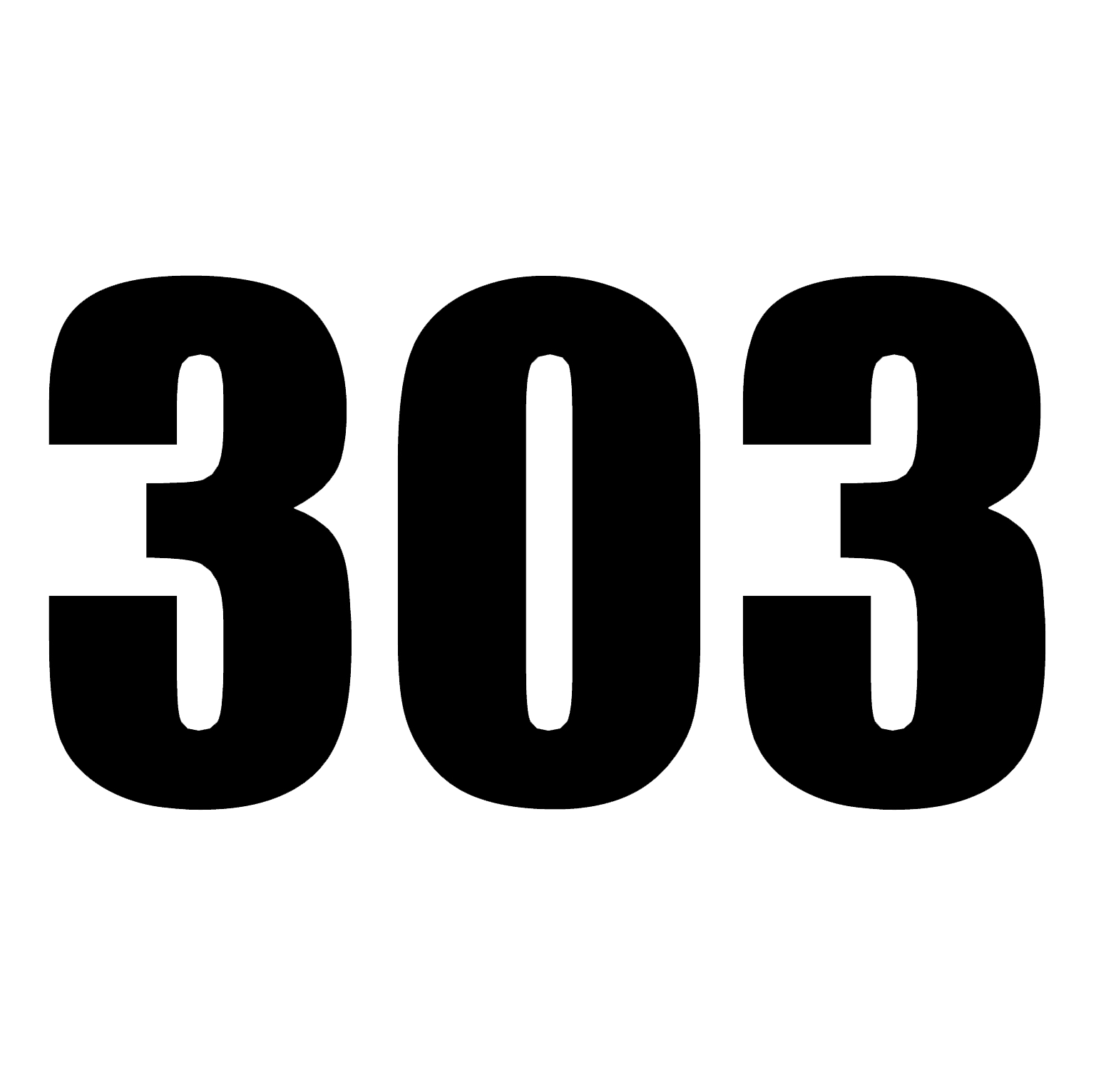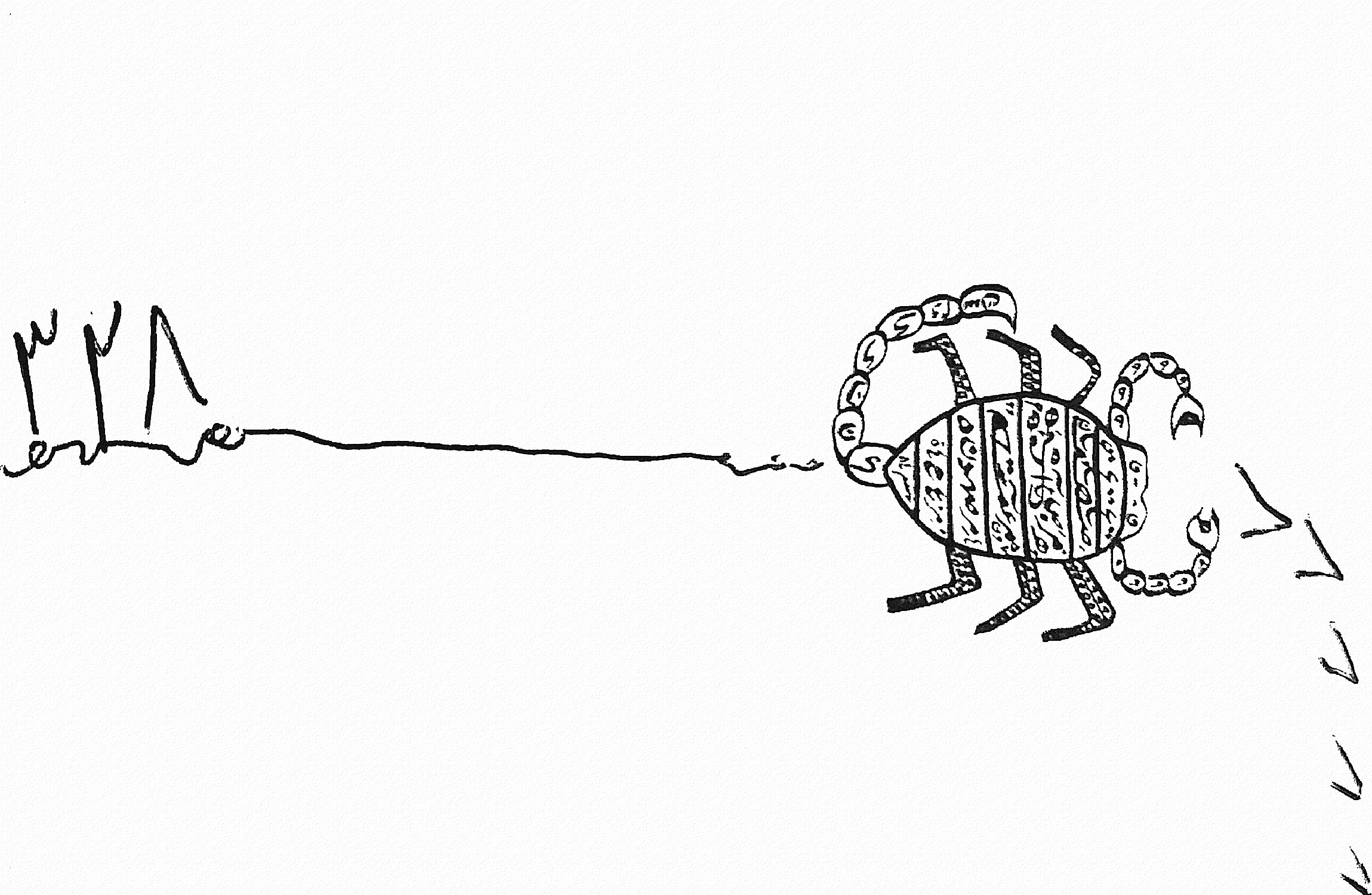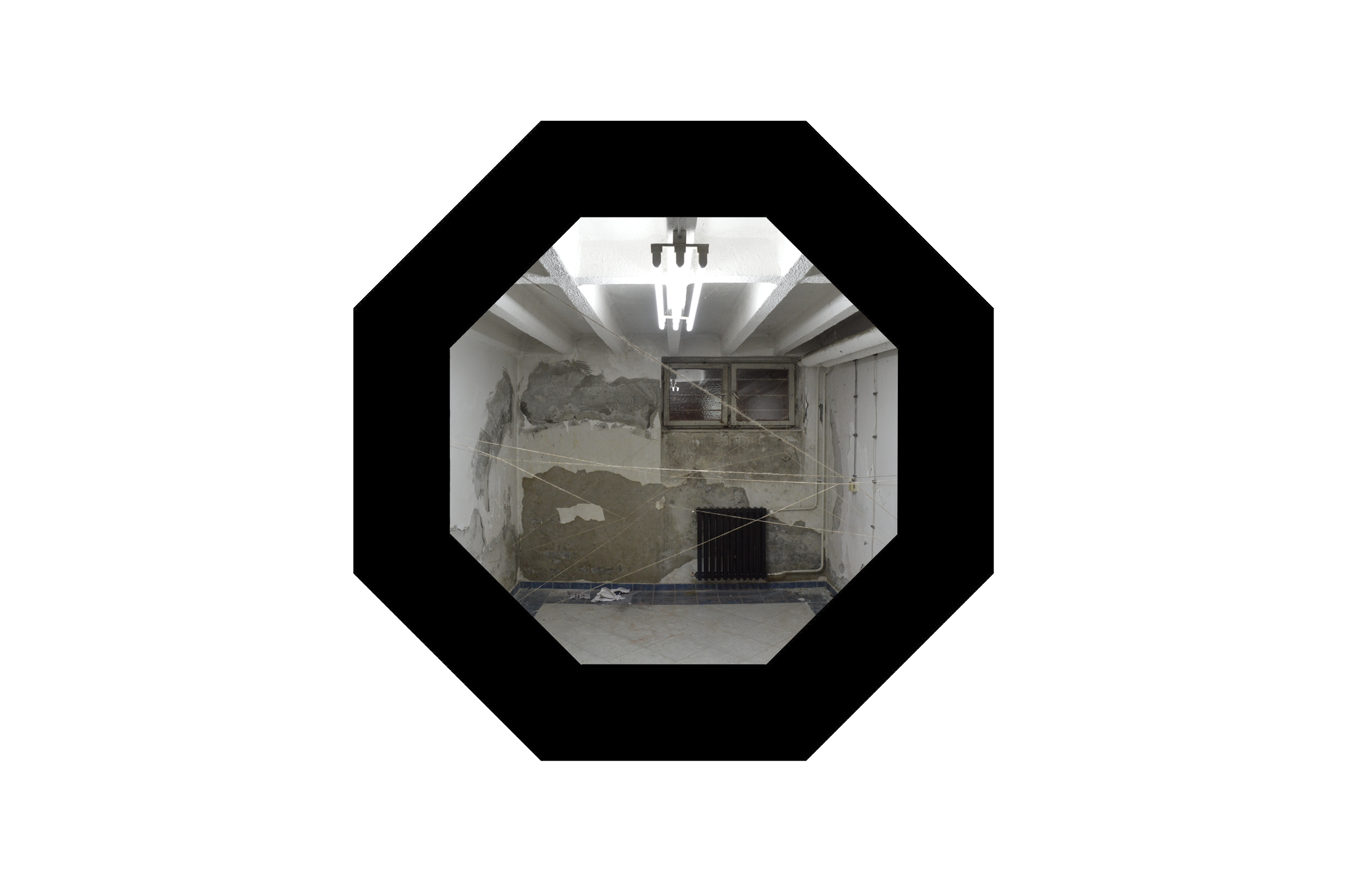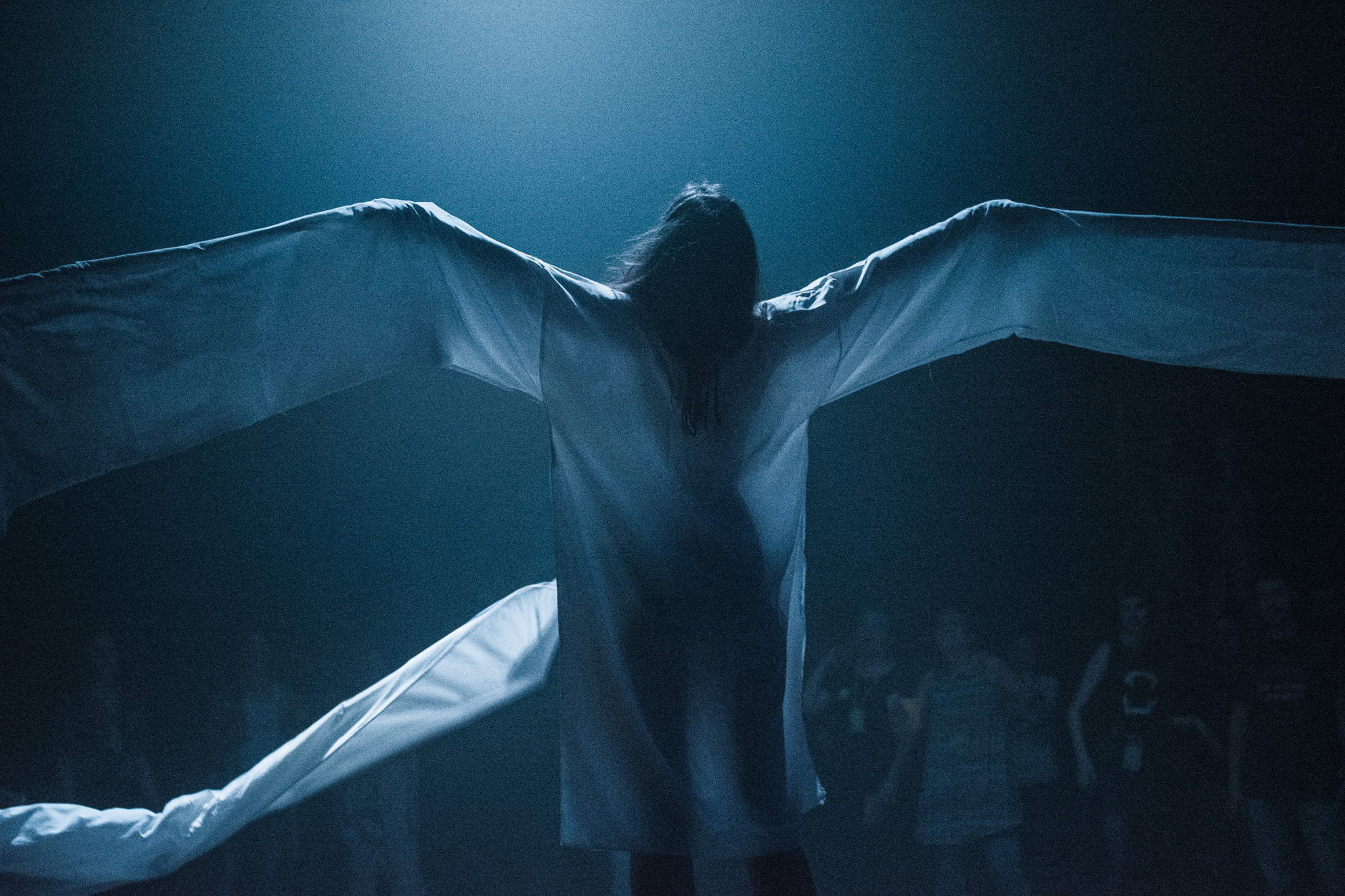Author: Darko Vukić, Belgrade
In the objects montaged for exhibition Torture Concrete, natural and industrial materials are mixed in a hybrid way, produced with procedures that are characteristic for science as much as they are for art. In the widest sense, Moulène’s project is an attempt to reconnect art with other modes of thinking. He strives towards experimental dissection and re-combination, which is most notable in this show with the object entitled Tête-à-Cul (Head-to-Ass, 2014), where the synthetic and yellowish skin is tightened through the cavities of an animal skull.

Looking at recent Moulène’s work includes, not just watching, but also an attempt to enter the depths of the interior of objects, their presence or materials; getting into the center. The attempt to access something aggressive, complicated or foreign, and by only accessible means: via speculation, imagination, experience, logic […] in the era of inertia of confirmation, bubbles of general consent, post-facto reporting and emotionally guided politics. We have entered a moment of polarization and fantasy with cavernous ethical and political divisions, which occasionally seem insurmountable. Certain works are exactly the material realization of this problem, representing affective gaps that are truly inaccessible. For instance, the group Tronches / Tormented Guard (2014) consisting of: concrete castings sealed in the faces of Halloween latex masks, turned upside down into hermetic objects. The view is fixed on one of them, on two lines of teeth strangely protruded, the impression is apparently taken from the other side of the set of teeth. The sight is now trying to turn upside down. This distortion sensation is very significant for the group of these monstrous faces, for which he is choosing segments for small formal inversions of inner-outer plans. Jean-Luc Moulène practices abstraction in a long forgotten tradition, in which the procedure of abstraction evolved as a power of thought that delineates matter and provides inertia a minded trust that determines the trajectories of thought and imagination. This tradition represents a history of development tools of thought and technology which are necessary for its self-transformation, at the level of the general structure as well as at the level of enabling the particular modes of thinking.
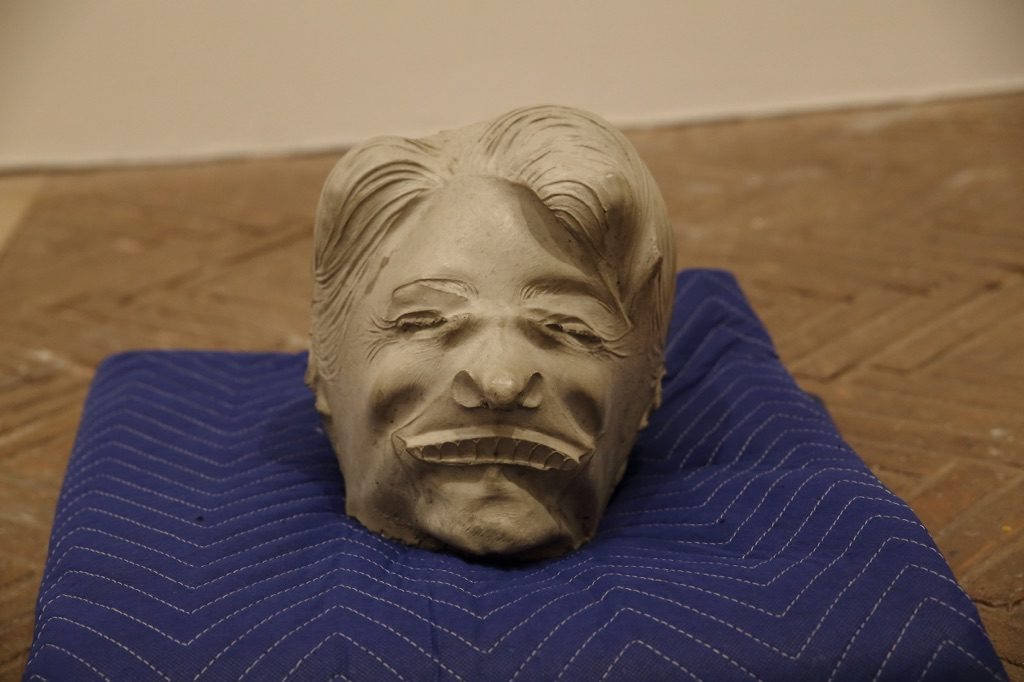
The author believes that his paintings and objects are actually tools, objects for use: primarily practical things. He points to the basic idea of the tool, which he describes as: reliance of tensions implicit to materials, operating and enduring those operations; emphasizing the importance of manipulation in his enigmatic and eclectic practice, as described by jukebox art magazines. His 3D works cannot be clearly indexed, and their corpus reveals a huge production variety. He insists calling them objects and not sculptures. He is grouping them under the title Opus, which represents an intense investigation of the formal possibilities of contemporary photography, painting and sculpture. Factory made objects, documentary type photo series and drawings in exhibition installations are set up without an obvious thematic, temporal and material relation. He treats the works as products: the term that connects their production status with the recognition of their commercial value and circulation mode. He distinguishes his objects and images in the following way: My wall images play on representation, while my objects play on presence. Now, the difference between the object and its display becomes more blurry. Most of contemporary objects are post-photographic, digitally designed, software-assembled artifacts: they exist as images even before they become objects. He declares: The idea is simple: if you objectify floating mental images, they no longer float, they become legible. My work has often been about that: giving concrete existence to mental images.
Moulène’s production, taken in its entirety, reflects the nature of artistic work and work as such. One video records a working period at the Marseille International Glass Center (CIRVA, Marseille); it displays a team of glass blowers that maneuver, process and cool these melted masses, with great effort to expand them into transparent balloons which are like a dome. Three colored glass knot, the Blown Knot 632 Borromean, Varia 03 and objects like this, rely on a significant presence of work – as a record of manual or digital transformation of raw materials into products – while images on the wall count on their representativity, as already said. The approach is here defined as a permanent examination of the relationship of form and thought abstraction, since the potential of formal variations is unspecified. The method of making objects and images represents a clear distancing from the canons and typologies of the media of art.
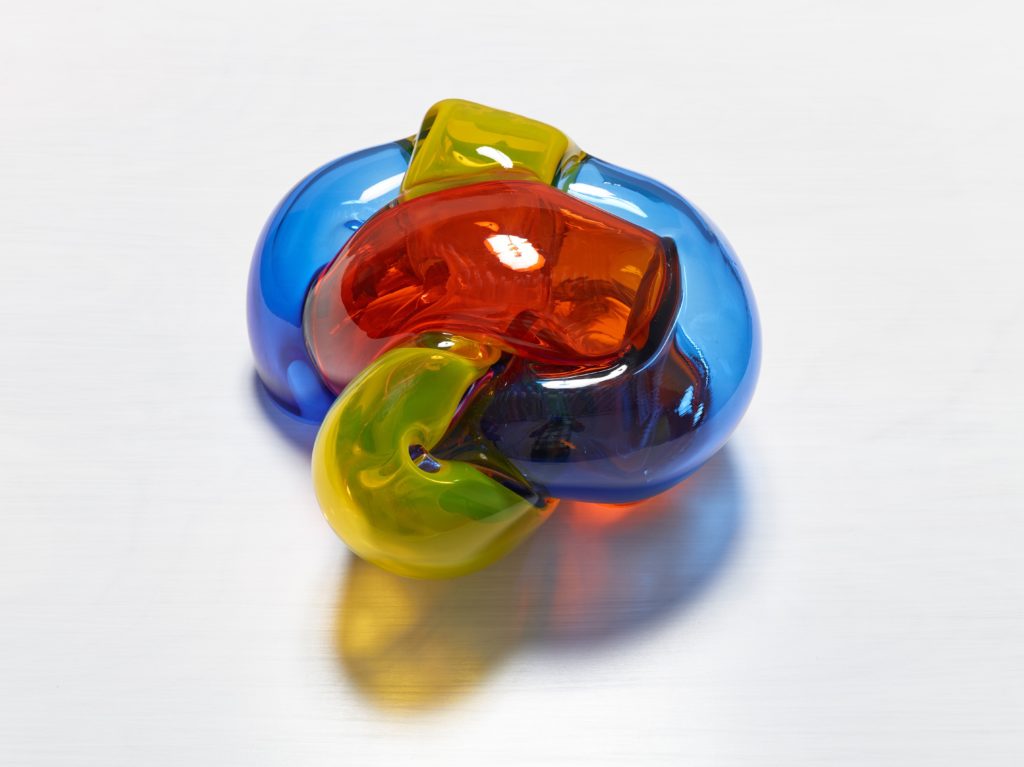
Moulène is a pragmatist who sees objects and images as tools for discovering social or natural phenomena, and a working method as a series of protocols. Primary concern here is the connection between the object and the image, but there is also a body – pre-born or already-dead, human and animal, in whole and in fragments, diminished, allegorical, carnal, grotesque or clinically precise… This pre-occupation with the body originated, in part, from Moulène’s acquaintance and cooperation with Michel Journiac, the founder of the French Body Art movement of the seventies.

Bronze and glass knots, cement heads and several photographs can appear seemingly unconnected at the exhibition, but they are united, precisely by the working paradigm of topology and dynamic systems that Moulène calls protocols. This operating mode allows a specific type of tangency between producer – production – and a product that, between the artist and his imagination comes across the will of the material and the artwork. Monitoring protocols, or certain autonomous guidelines, implies action in accordance with the ramification of the transition of thought into matter, in the search for integrity in variation, and the opportunities to participate in variations based on their fundamental invariability, that is, invariance, as Reza Negarestani writes in the accompanying essay.

The knot represents the fixation in a given condensation state. It represents a state of tension, a complex, a tangled unclear situation, and the type of mental labyrinth through which it passes to a solution. Engaging the physical-mathematical entity – knot as the protocol for construction – Moulène transcended a conventional view on art, rediscovering the task of its power to redistribute and destabilize the configuration of relations between understanding, imaginativity, and embodiment, which opens an expanded field of perplexity. However, this space of doubt is generative – it demands new strategies and produces possibilities for the orientation of thought. He reactivates the abstraction as the art of translating that is, making of mutual perturbations of thoughts and matter comprehensible, by organization of space through which their respective forces are expressed. Through the logic of the knot, it is finally possible to establish the formal cruelty of thought, back to the domain of the carnal, either by giving flesh to the transcendental torture of abstraction or allowing the bodily to radiate the abstract discomfort of the geometric body of art. The knot is an abstract torture that became via flesh. But the flesh – head, concretized or concrete mask – is a knot filled with different densities of abstraction. By connecting itself with itself, the knot refuses to be annulled. It registers itself as a new intuition for the thought determined to be transformed, by exposing itself to the expressions of the comprehensibility of the material domain, and by following new protocols of thinking in which the rules of thought and the laws of nature collide, the latter imprint themselves on the former.
Moulène conducts an emancipatory procedure of releasing thought from the claws of any external cause that could determine it. The task of abstraction in this scenario, according to Reza, is to set free the virtual subject – a certain force of thought. The aforementioned bronze knots were placed next to the glass ones in one room. As long as the protocol of knot is concerned, a space can be imposed by an imaginary rope or blown at a floating point-glass, and in both cases it will produce a knot. For him, what distinguishes a bronze knot from a glass knot is simply a matter of following protocols with different constraints, or the density of space: imploded and exploded, contracted and dilated. Castings of concrete heads are another variant of the knot, in its fully condensed and simple form of only one rounded-loop surface. In this way, the dualities of inner–outer, negative and positive space, abstract and concrete are abolished. Furthermore, he destabilizes and plays with old artistic genres of portraiture, as well as with the types of monuments. For example, by purchasing flexible plastic masks, of various characters and figures from popular culture, pulling them from inside-out, neutralizing their caricature representations by casting concrete into proper openings, while two materials at hand do not find some sort of disturbed equilibrium. As with cutting the classical sculptures or monuments, into different groups of these obtained lutes. These concrete rococo parts, at first glance, a group of nudes and fauns mixed, seem as authentic and ruinous. Then, we notice the way he cut through these figures and brought them together into unusual set. All parts of the casts and the cuts of the body are joined together by the manic mounting of the psycho-cut traditional form. The concrete head of the wolf is also cut into two parts, so that the skull soaked in concrete is visible. The combination of concrete and bone is also used in an object called Arthur (2010), a human skull and concrete joint that looks like a helmet or VR glasses. Moulène makes such assembling works, because his sensitivity and impatience are met in stimulating and disturbing ways. All the cutting and remixing releases new powerful and potent images.
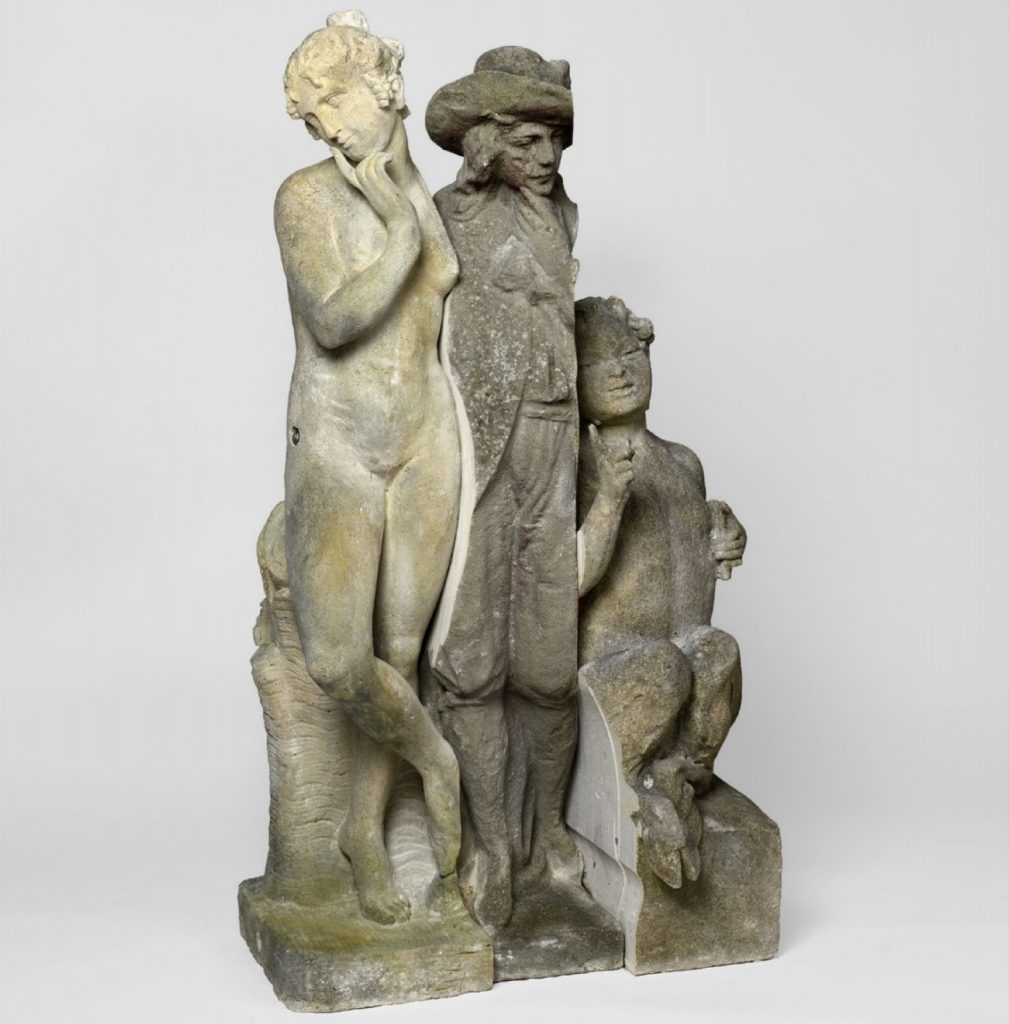
Works from the exhibition Larvae and Ghosts, are inspired by Rimbaud’s Vowels, the source of chopped imagery, leading to a different decoding. This exhibition is according to Moulène’s words: as always experimental. He says that he does not try to produce an effect, but he only tries to think, and thinking is an abstraction. It is a process of thinking about what can evoke, engage and accelerate interpretation, and the interpretation in his case takes up the space with agitation. In Larvae & Ghosts I have essentially made some abstract gestures, but applied to figurative objects. The main question is, what is the significance of a cut? What does it mean to fit in with someone, fit into a world or a culture? So we took diverse objects, such as garden sculptures, cast skeletons and plastic furniture and made cuts in them in order to make them fit with each other, in a concrete sense.
The Secession Knot 5.1 is a site-specific intervention by Jean-Luc Moulène in the gallery space of the Vienna Secession. Wooden strips, colored in black and neon yellow, form a knot in space that engages architecture in dialogue, while establishing a space with different traits in which he presents additional works. The helical wooden tape extends over the walls, ceiling and floors, crossing itself altogether five times – this five-fold crossing is referred to in the number 5 in the title. The wooden tape structures the gallery and divides it into segments of different spatial qualities in which objects are placed and some are built on site. The alternation of black and yellow generates an extremely hypnotic rhythm, which is enhanced by different lengths of wooden elements and the quality of color and material. Each corner, each element, expanded in space sections, is a specific constructive problem that calls for a single solution. The black parts of the wood owe their colored saturation and intense shine with a double coating of tar, while the radiation of the yellow elements was followed by bold use of neon color, and the radiation of yellow always exceeds its frame. Observed together, they are very striking, and thus a very efficient combination of colors in typography. Most of these objects are conceived especially for Secession and refer to the paint covered images from the newspapers, Brèves, his art book which will be published within the exhibition, and thus will be a program that relies on the displayed objects that spread in a mysterious and ephemeral series with fields sprinkled with space knot.
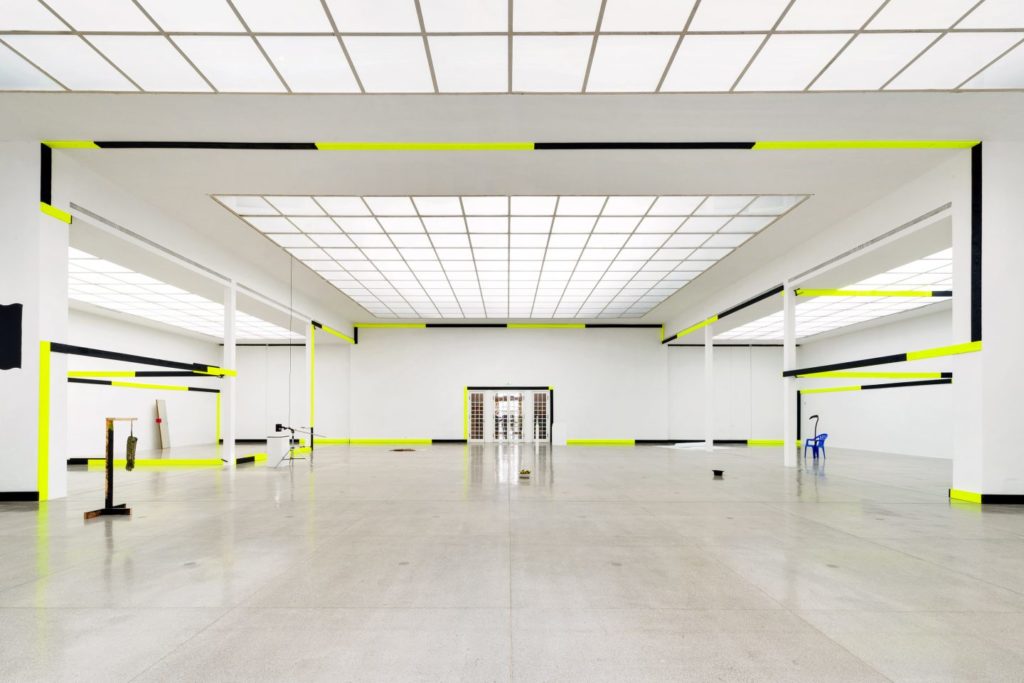
The mathematical function of the knot as well as its symbolic significance – were a continuous interest in Moulène’s art. He translates knot theory, a mathematical system that describes complex, i.e., tangled situations into art, with an effort to deal with its complexity. As he himself notices: the field of art, it is far from being calm, it is the zone of conflict: every artwork implies “yes” and “no,” while an observer is challenged to define his own position. The knot of the Secession apparently organizes space, but ultimately it is a metaphor. The interrelation between architecture and knot is described as the relationship between the servant and the master. In the final interpretations, freedom is yet the one that is most in question. The human body and its absence, volumes, surfaces and boundaries – are reverse motifs.
The consequence of every tension, whether it was cognitive, libidinal or political, rests on its potential for abstraction, on excitement and stabilization of new forms of collusion between understanding, the effective articulation of intelligibility and the behavior of the materials. But abstraction itself, is the space of the maximum tension. However, this is a tension that precedes any libidinal, social or political narrative, in any case it can be implemented and put into motion, in different contexts and in accordance with their specific rules and requirements. It is exactly the tension of abstraction that Moulène tends to emphasize and reactivate within any framework or narrative, whether it is political, libidinal, or mathematical.
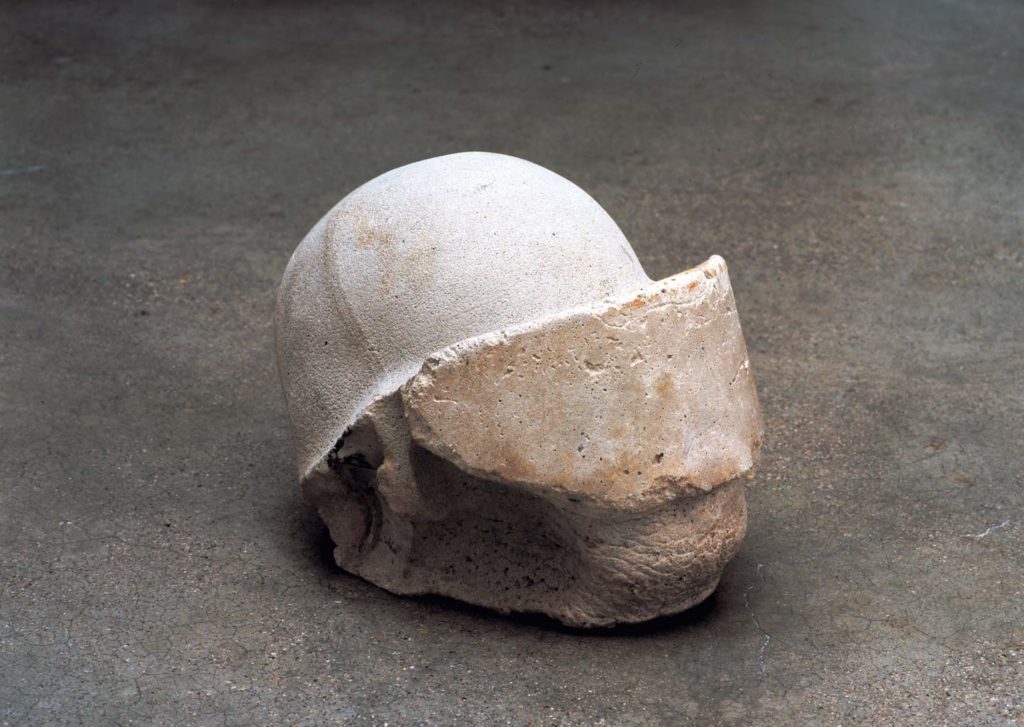
Jean-Luc Moulène (1955) French artist. Presents his work from second half of 1980. He studied at Sorbonne (Aesthetics and Science of Art) in Paris, where he still lives and works.
Sources of Information (articles and reviews):
– Vivian Sky Rehber, Art of Work, Jean-Luc Moulène’s enigmatic responses to creativity and labour, Frieze, Issue 182, October 2016.
– McLean- Ferris, Laura, Conflicts of Interest. Flash Art, October 2016.
– Jonathan Jones, Jean-Luc Moulène review – who knew French art could be so funny?, The Guardian, 14 April 2016.
– Mitch Speed, review Jean-Luc Moulène, Frieze, Issue 168, Jan-Feb 2015.
– Reza Negarestani, Torture Concrete: Jean-Luc Moulène and the Protocol of Abstraction, Sequence Press, New York, 2014.
– Gerbran, Ž. Ševalije, Dictionary of Symbols, Kiša/Stylos, Novi Sad, 2004.
Internet sources:
https://frieze.com/article/jean-luc-moul%C3%A8ne-0?language=de
https://www.secession.at/en/exhibition/jean-luc-moulene/
http://purple.fr/diary/an-exclusive-interview-with-french-artist-jean-luc-moulene-on-his-new-exhibition-larvae-and-ghosts-at-thomas-dane-gallery-london/
https://www.youtube.com/watch?v=RYrIRG-OF88
Exhibitions (mentioned in the text):
Secession Vienna, Jean-Luc-Moulène, The-Secession-Knot (5.1), 2017.
Thomas Dane Gallery, Jean-Luc Moulène, Larvae & Ghosts, 2016.
Miguel Abreu Gallery, Jean-Luc Moulène, Torture Concrete, 2014.
Short Biography:
Darko Vukić (1992). Visual artist and author, graduated Painting and Transmedia Research at Faculty of Fine Arts (FFA) in Belgrade, 2016. Currently PhD student at the same faculty. He is dealing with textual experimentation and theory-fiction, the ways in which those texts could be treated vocally through software interventions into hallucinatory and haptic sonic experience related to space, under the ongoing project Fables. His texts and visual interventions are published in magazines and exhibition publications. He is a curator of Prosthetic pavilion of third edition of The Wrong – digital art biennale 2017/18, and also of the upcoming edition 2019/20. Featured in numerous solo and group shows, he also displays his generative video art on festivals across the globe.
